After an enforced break of a week, there is plenty to look back on over the past fortnight.
Further work has been carried out on FR 20’s boiler by Andy Booth and it is hoped to have the job of expanding and beading over the tubes finished this next week. The tender has received plenty of attention with John Dixon leading the task of examining and cleaning up the front drag box. 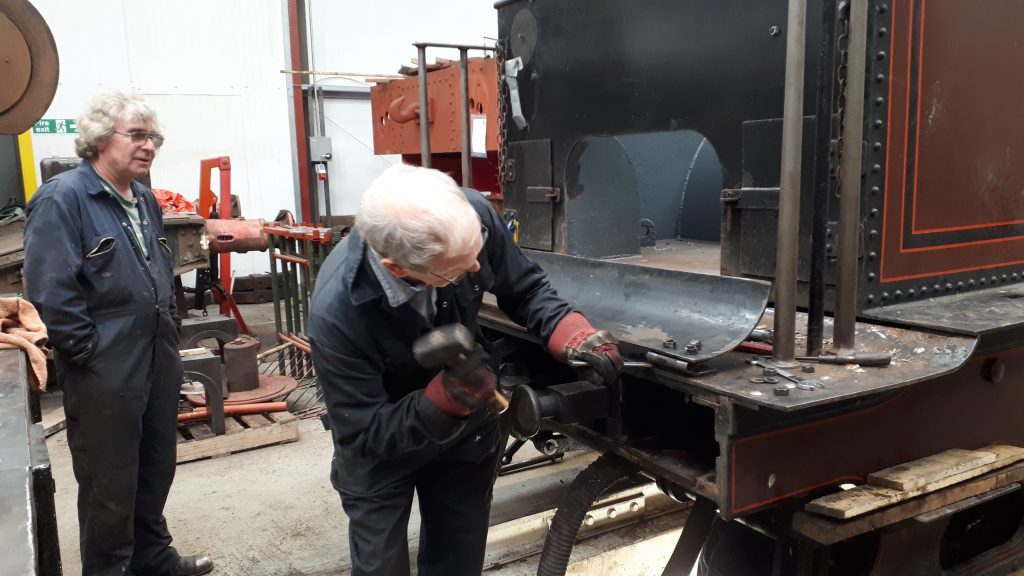 First it was necessary to remove the curved fall plate, the bridging piece between the tender and the engine.
First it was necessary to remove the curved fall plate, the bridging piece between the tender and the engine.
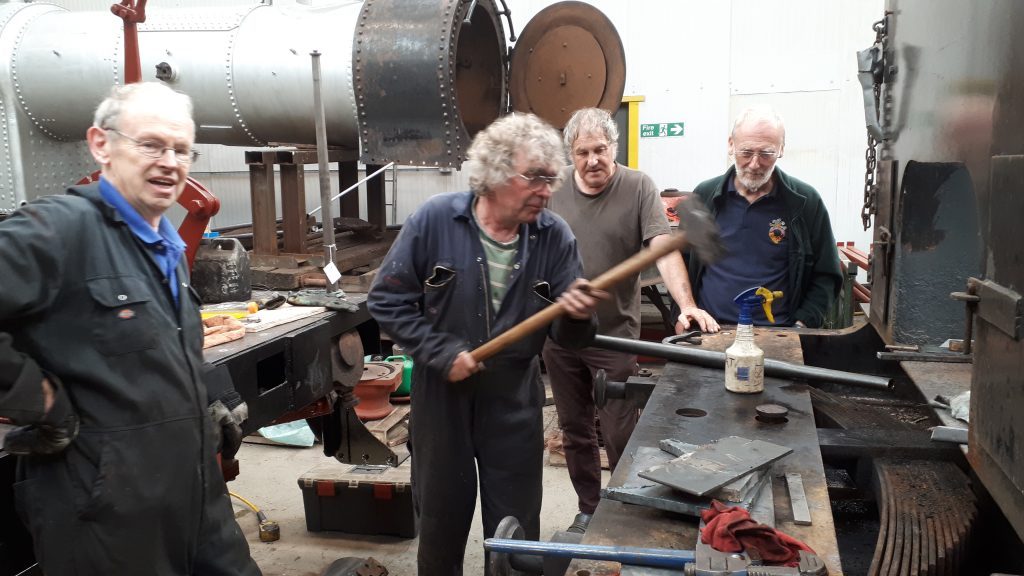 Once the tender floor plate had been removed, there was then the more difficult task of removing the thick plate directly above the drag box which could not be moved until both the draw bar pin and the buffing spring pin had been removed. The latter was found to be seized in the lower base plate and so it was time to call in Ade, who has “previous” in taking apart those things that don’t want to come apart! With assistance from Tim also, the pin was finally extracted late last Wednesday afternoon after many applications of jack, heat and a sledgehammer. Ade is seen here at work with the latter, watched by John Dixon, Keith Brewer and Neil Glover.
Once the tender floor plate had been removed, there was then the more difficult task of removing the thick plate directly above the drag box which could not be moved until both the draw bar pin and the buffing spring pin had been removed. The latter was found to be seized in the lower base plate and so it was time to call in Ade, who has “previous” in taking apart those things that don’t want to come apart! With assistance from Tim also, the pin was finally extracted late last Wednesday afternoon after many applications of jack, heat and a sledgehammer. Ade is seen here at work with the latter, watched by John Dixon, Keith Brewer and Neil Glover.
It was then just a case of getting four pairs of hands to remove the main plate and to expose the drag box for the first time in over twenty years.
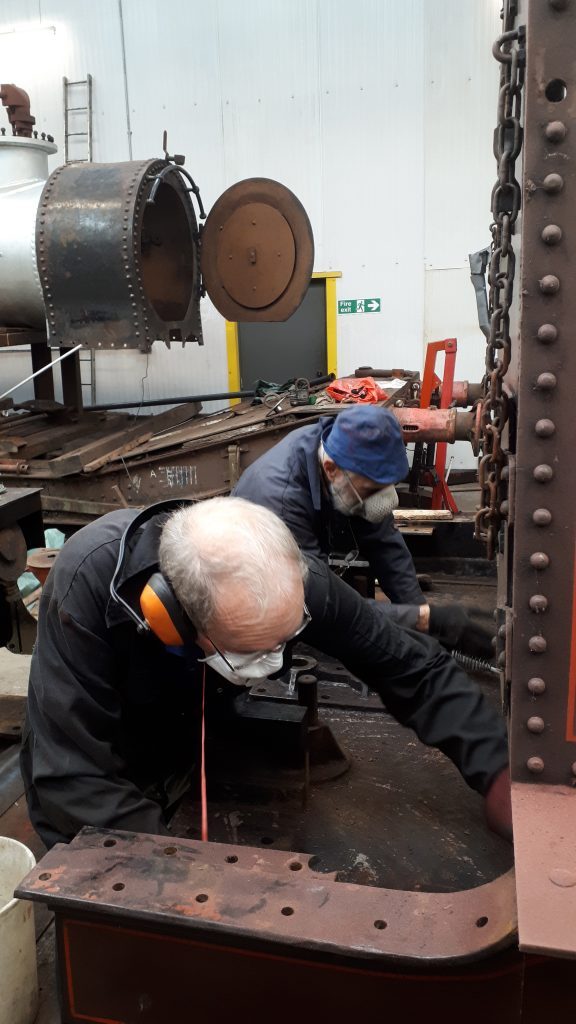 Once two of the buffer guides and the buffers had been removed, Roger then assisted John last Friday in the task of cleaning up the drag box.
Once two of the buffer guides and the buffers had been removed, Roger then assisted John last Friday in the task of cleaning up the drag box.
 A coat of bright orange primer was then applied.
A coat of bright orange primer was then applied.
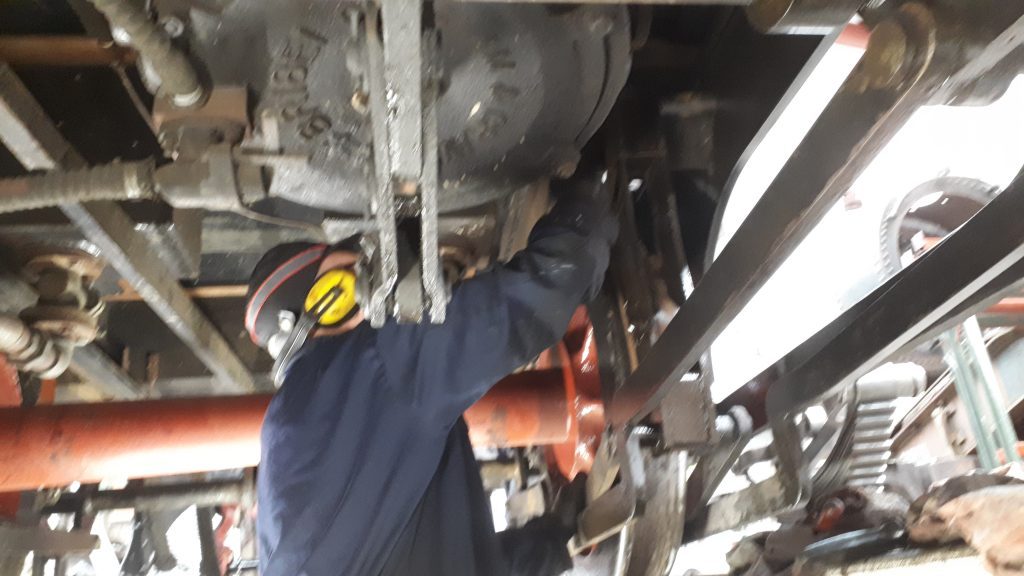 Meanwhile Tim has been sanding down the one of the tender sides and Phil Bell has been cleaning the tender brake rigging.
Meanwhile Tim has been sanding down the one of the tender sides and Phil Bell has been cleaning the tender brake rigging.
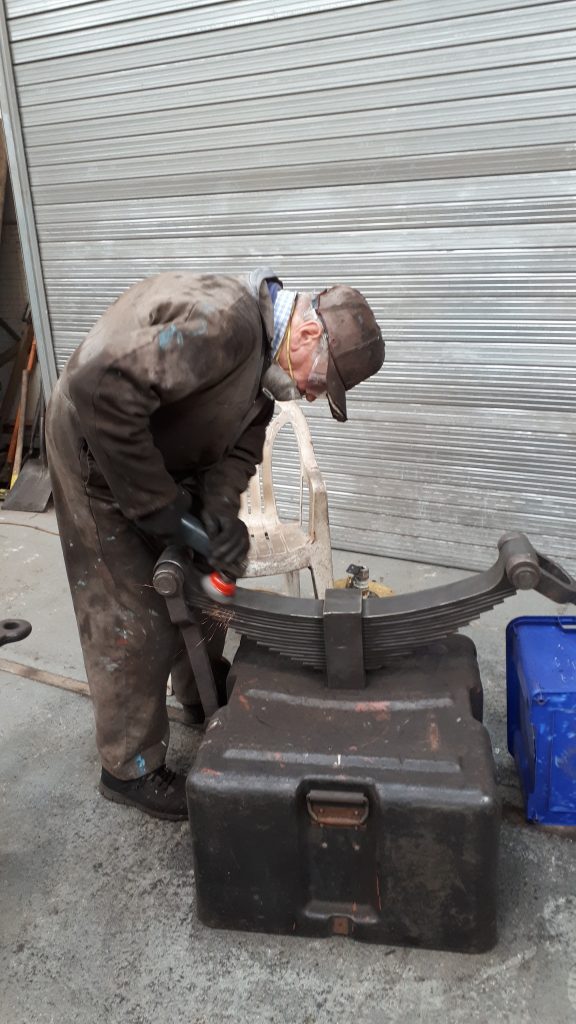 Fred has been busying himself cleaning the tender springs and hangers.
Fred has been busying himself cleaning the tender springs and hangers.
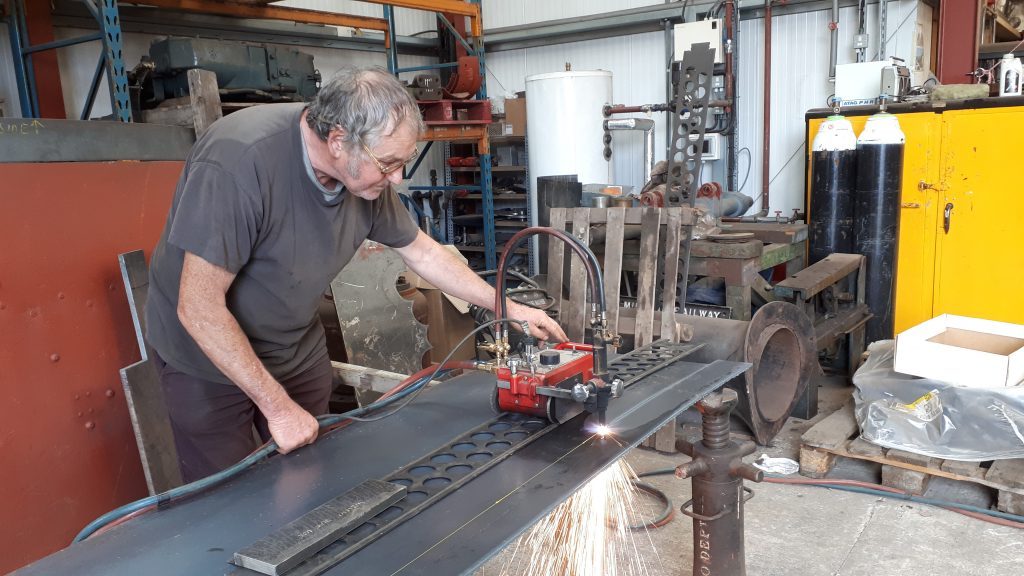 Keith has been cutting out new sheet metal for Fluff‘s running board.
Keith has been cutting out new sheet metal for Fluff‘s running board.
 This was then successfully lifted into position and fitted.
This was then successfully lifted into position and fitted.
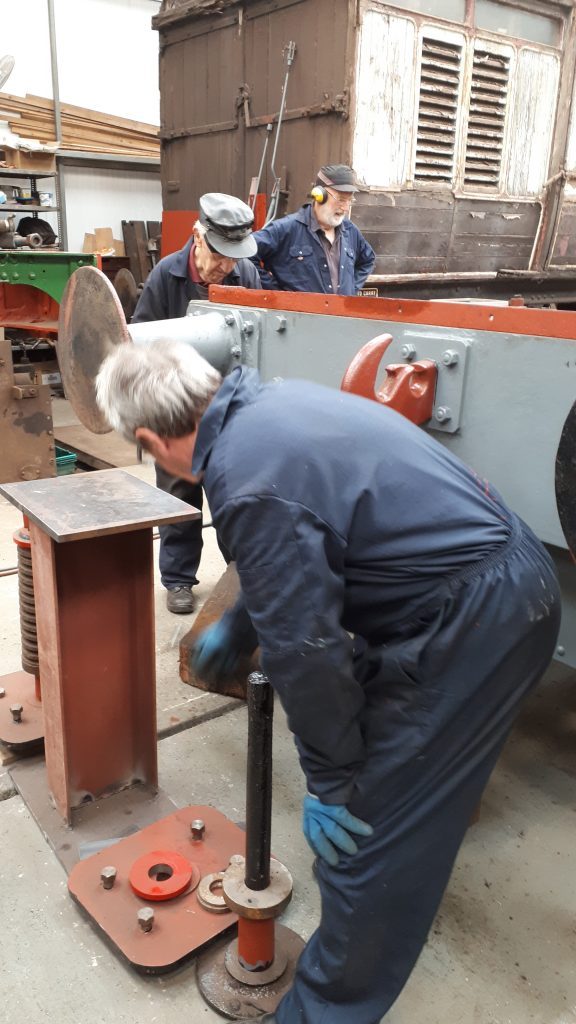 Paul Balshaw commenced the task of jacking up Fluff last Wednesday so that the wheels could be removed and axleboxes examined.
Paul Balshaw commenced the task of jacking up Fluff last Wednesday so that the wheels could be removed and axleboxes examined.
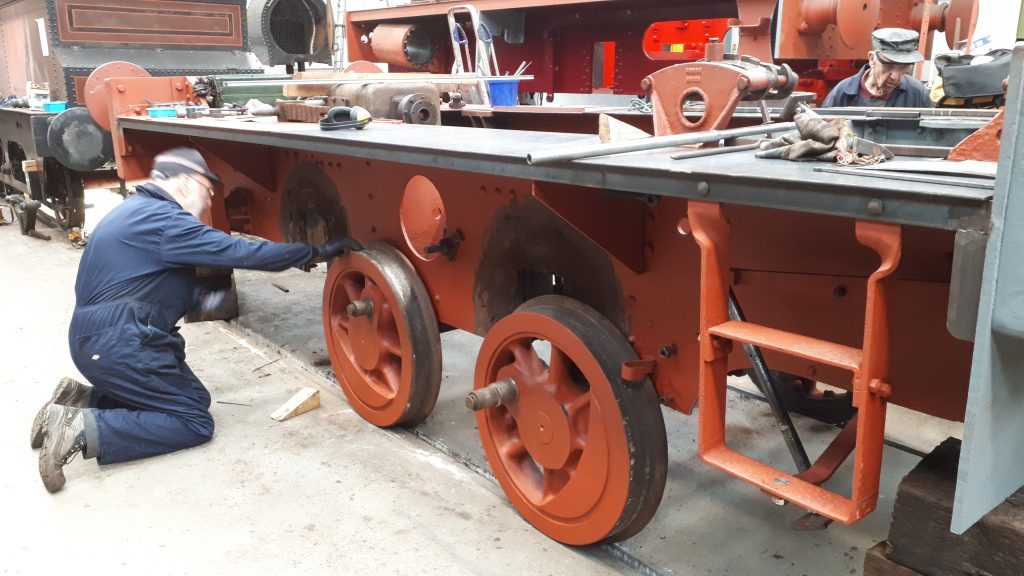 Phil Bell is seen moving the wheels once the frames had been jacked high enough.
Phil Bell is seen moving the wheels once the frames had been jacked high enough.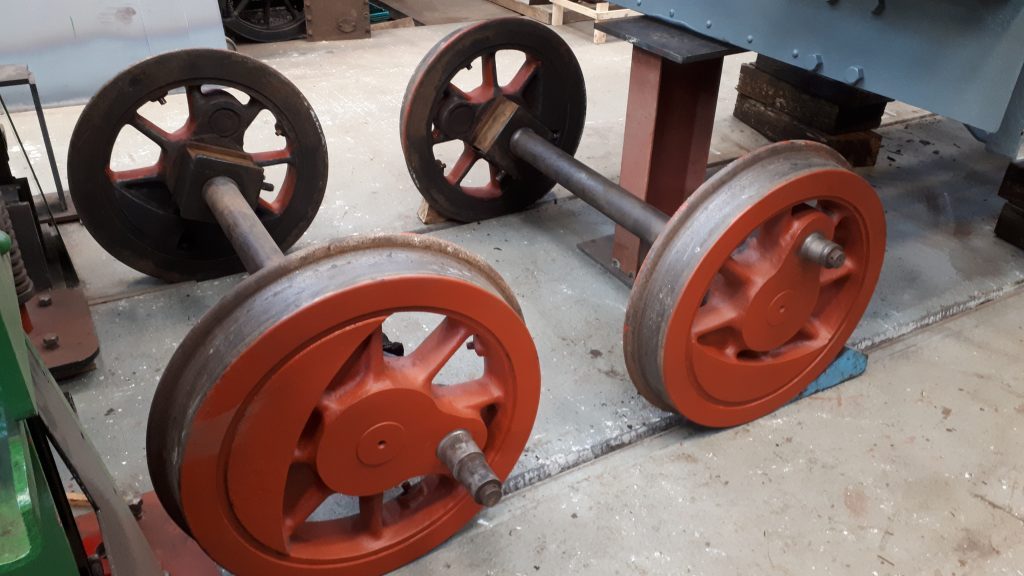
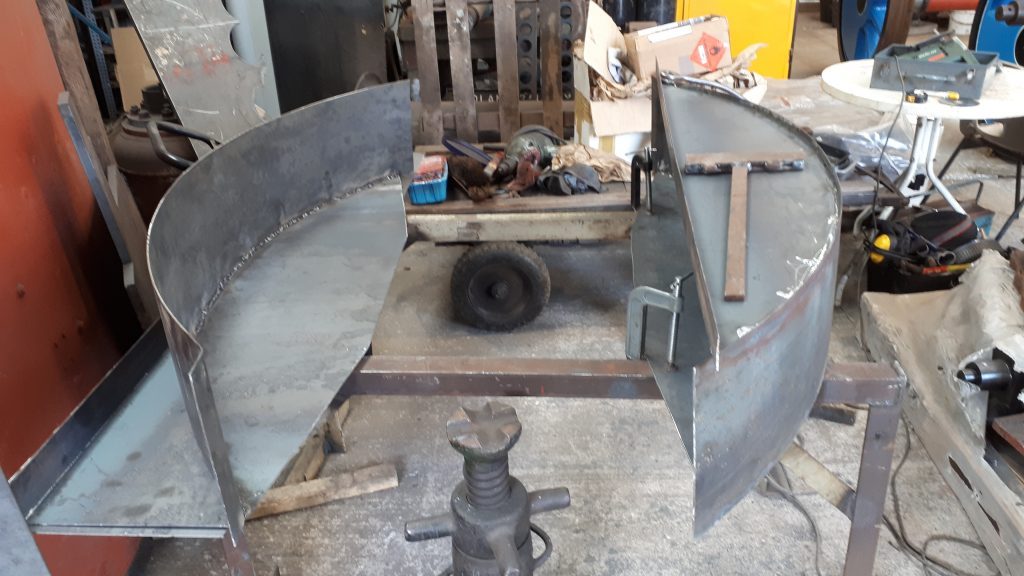 Keith has also been concentrating his time recently in manufacturing new splashers for Wootton Hall.
Keith has also been concentrating his time recently in manufacturing new splashers for Wootton Hall.
Over at Embsay, Cumbria passed its statutory cold boiler examination on 16th September and, after re-assembly of its fittings, was given a test steaming last Thursday. This confirmed that the recent efforts of Charles Adams and his team had been successful in resolving the passing of steam through the regulator valve when closed. Also tested was the brake valve which had undergone a rebuild by Barry Gambles of South Coast Steam.  Disappointingly, the newly acquired regulator quadrant fell at the first hurdle with the end stop coming adrift.
Disappointingly, the newly acquired regulator quadrant fell at the first hurdle with the end stop coming adrift.
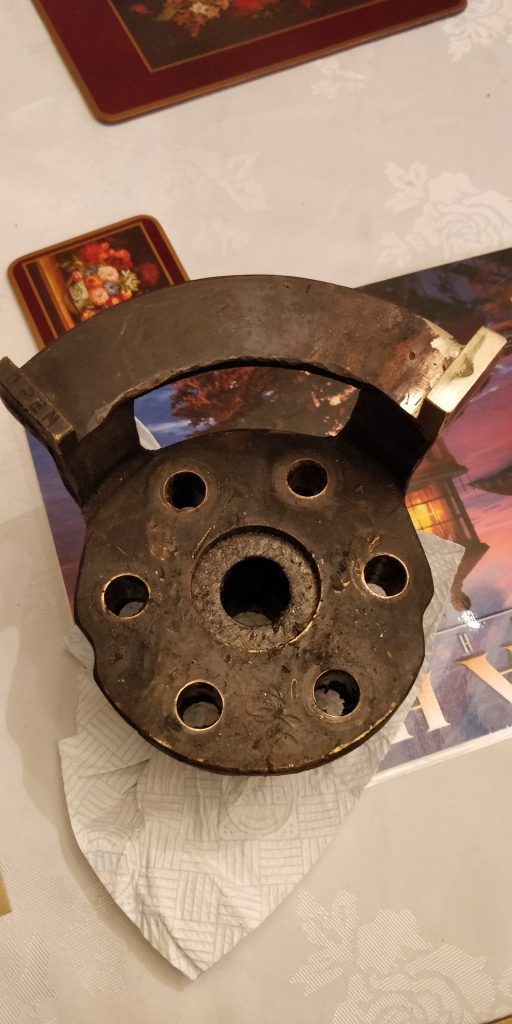 This has now been successfully repaired and re-fitted.
This has now been successfully repaired and re-fitted.
We now await the formal steam test with the boiler surveyor after which, all being well, there will be a carefully monitored return to service. 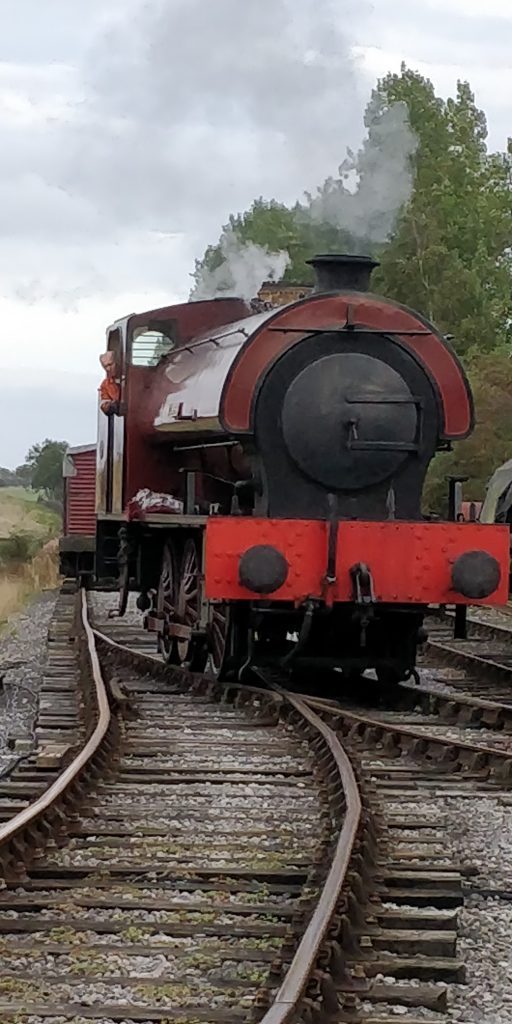 In the meantime we show a photo of Cumbria whilst shunting during its test steaming.
In the meantime we show a photo of Cumbria whilst shunting during its test steaming.
A reminder that the Ribble Steam Railway’s Diesel Gala takes place next Saturday and Sunday with a Folk Evening next Saturday evening.
 More good progress was made with Caliban last Wednesday with Alan tackling the job of scraping in the newly re-metalled bearings.
More good progress was made with Caliban last Wednesday with Alan tackling the job of scraping in the newly re-metalled bearings.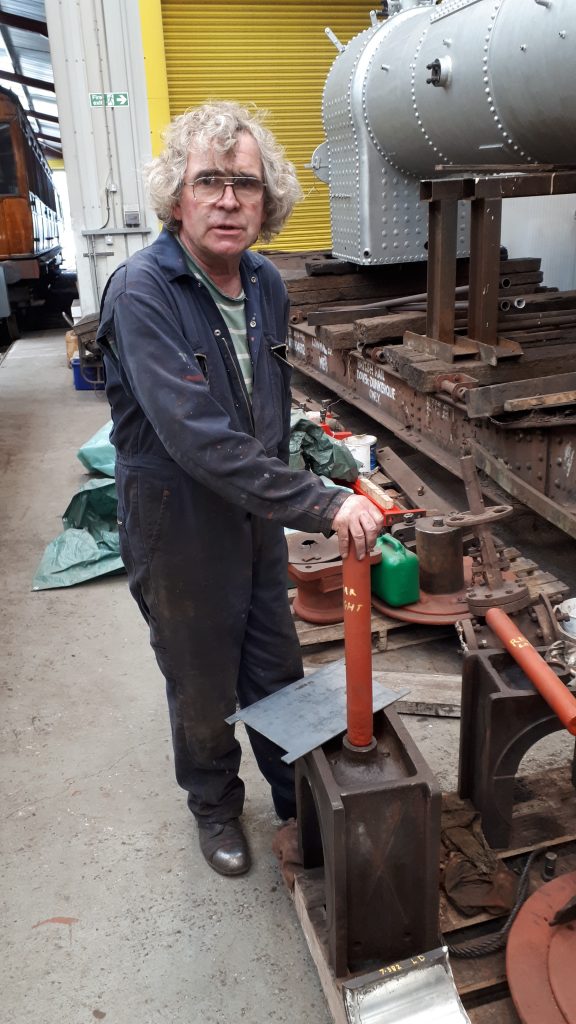 With the vision of the locomotive being lowered back on to its wheels in the not too distant future, Ade was checking the spring support pins.
With the vision of the locomotive being lowered back on to its wheels in the not too distant future, Ade was checking the spring support pins. Also achieved last Wednesday, in good time before the lowering of the loco, was the lining out of Caliban‘s wheels.
Also achieved last Wednesday, in good time before the lowering of the loco, was the lining out of Caliban‘s wheels.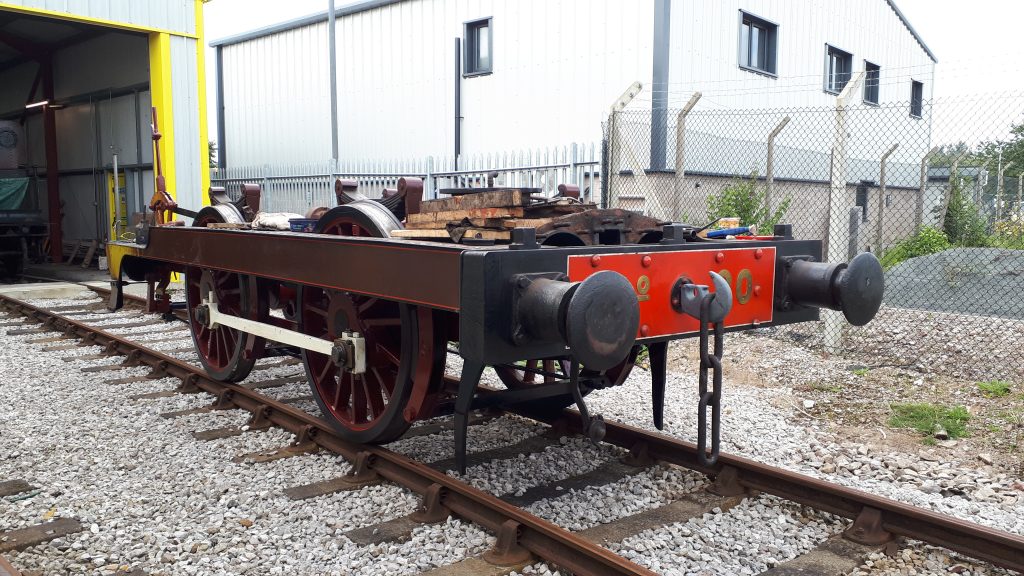 As forecast in last week’s blog, Ade conducted a shunt which enabled Fluff and FR 20, complete with tender, to be positioned on road three of the heated section of the FRT shed in readiness for the winter work programme. Fortunately it was possible to do the shunt whilst the rain held off and FR 20’s frames made a rare appearance out in the open.
As forecast in last week’s blog, Ade conducted a shunt which enabled Fluff and FR 20, complete with tender, to be positioned on road three of the heated section of the FRT shed in readiness for the winter work programme. Fortunately it was possible to do the shunt whilst the rain held off and FR 20’s frames made a rare appearance out in the open. The new line up in the shed is seen here.
The new line up in the shed is seen here.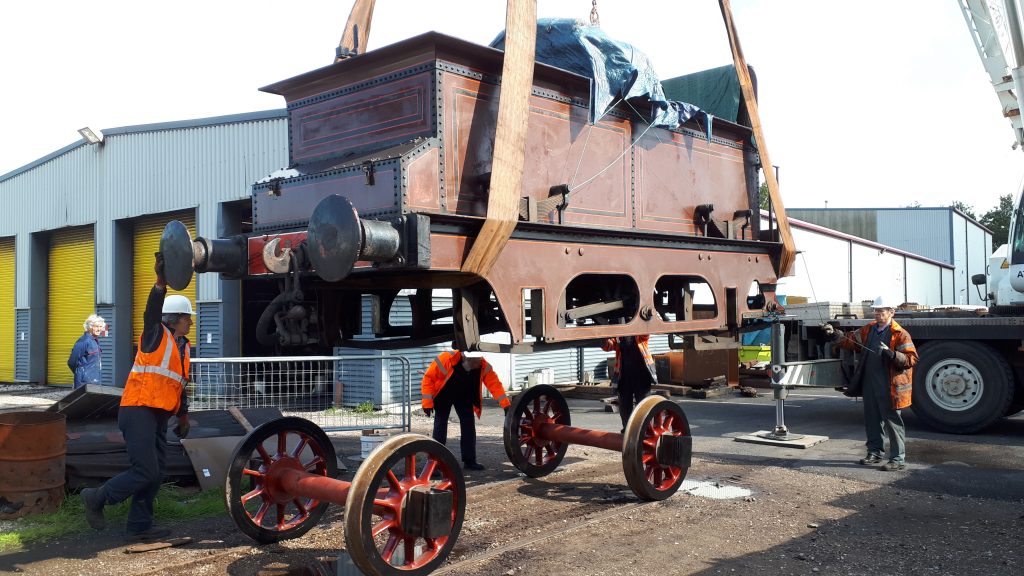 FR 20’s tender chassis was duly reunited with its wheels last Wednesday although the blustery wind did its damndest to try and make life difficult for us.
FR 20’s tender chassis was duly reunited with its wheels last Wednesday although the blustery wind did its damndest to try and make life difficult for us.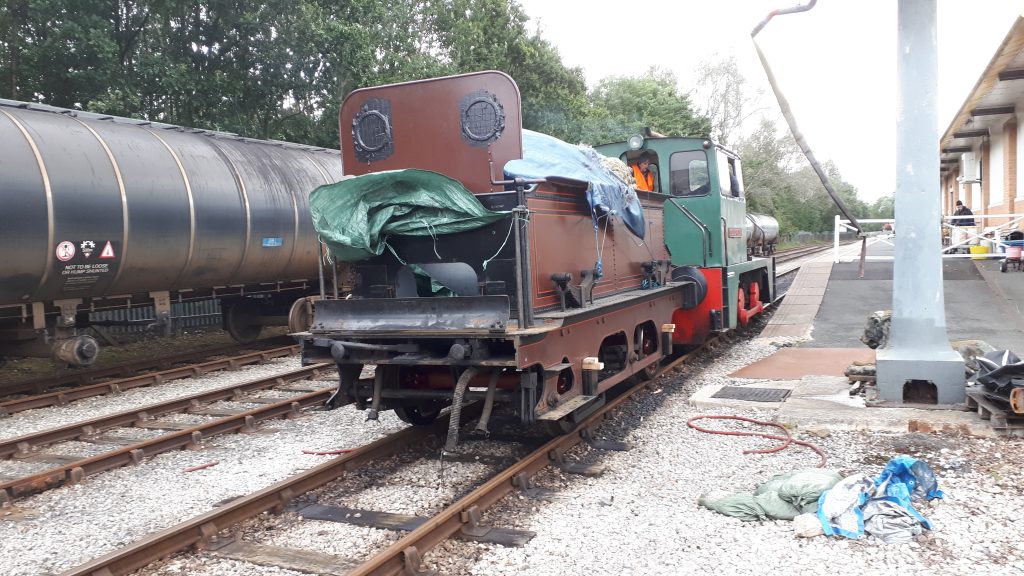 However, patience paid off and, after a successful struggle in damp conditions to re-fit the brake gear, the tender was shunted around to the FRT shed late afternoon after Ade had shunted around some more coaches for the RSR.
However, patience paid off and, after a successful struggle in damp conditions to re-fit the brake gear, the tender was shunted around to the FRT shed late afternoon after Ade had shunted around some more coaches for the RSR.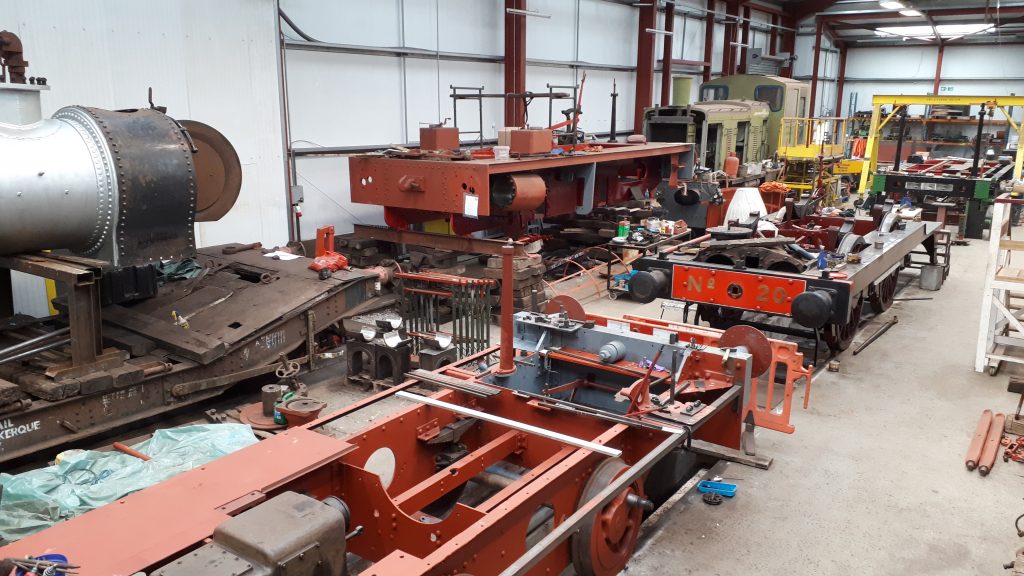 We show here a last look at the FRT shed before items are moved around, with FR 20’s boiler (left), Fluff‘s frames (foreground), Caliban (distant left), FR 20’s engine frames and Wootton Hall‘s tender frames (distant right).
We show here a last look at the FRT shed before items are moved around, with FR 20’s boiler (left), Fluff‘s frames (foreground), Caliban (distant left), FR 20’s engine frames and Wootton Hall‘s tender frames (distant right). In the meantime work has continued in rebuilding the platework and assembling other components, with Phil Bell giving the newly fabricated cab sides a coat of red oxide.
In the meantime work has continued in rebuilding the platework and assembling other components, with Phil Bell giving the newly fabricated cab sides a coat of red oxide.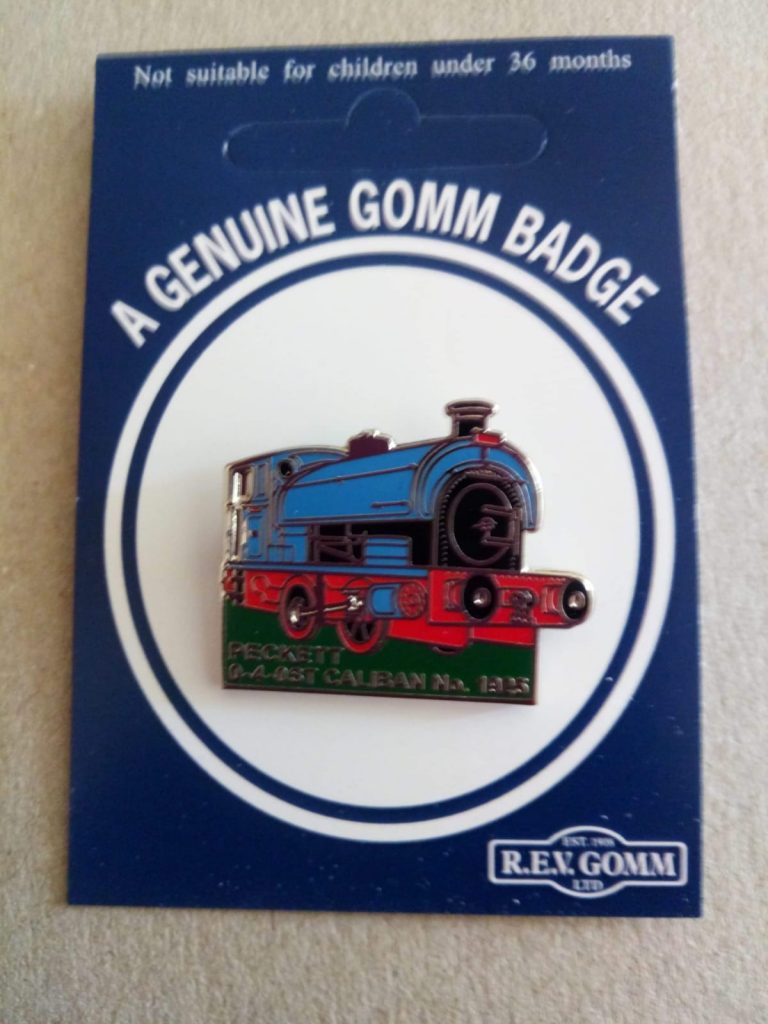 Finally, on the sales side, Alison informs us that she now has a brand new badge depicting Caliban for sale. Please contact either Alison or Alan if you would like to purchase one, with a special members’ rate available.
Finally, on the sales side, Alison informs us that she now has a brand new badge depicting Caliban for sale. Please contact either Alison or Alan if you would like to purchase one, with a special members’ rate available. Wednesday saw FR 20’s tender axleboxes being re-assembled and mounted on the journals. This is in readiness for the arrival of a crane this next Wednesday morning when it is planned to place the tender back on its wheels.
Wednesday saw FR 20’s tender axleboxes being re-assembled and mounted on the journals. This is in readiness for the arrival of a crane this next Wednesday morning when it is planned to place the tender back on its wheels.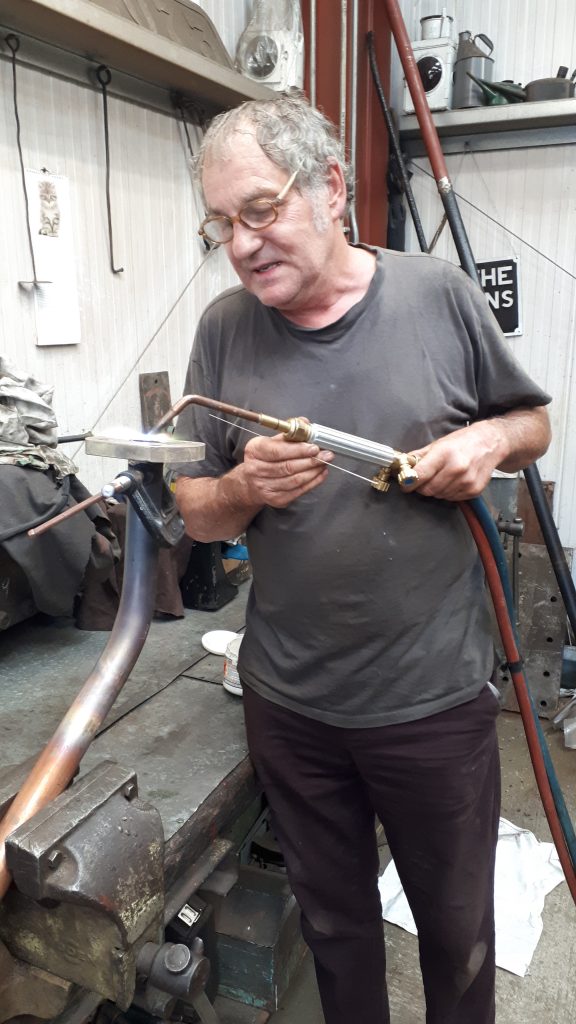 We include a photo this week of Keith silver soldering a flange on to a piece of Wootton Hall‘s injector pipework.
We include a photo this week of Keith silver soldering a flange on to a piece of Wootton Hall‘s injector pipework.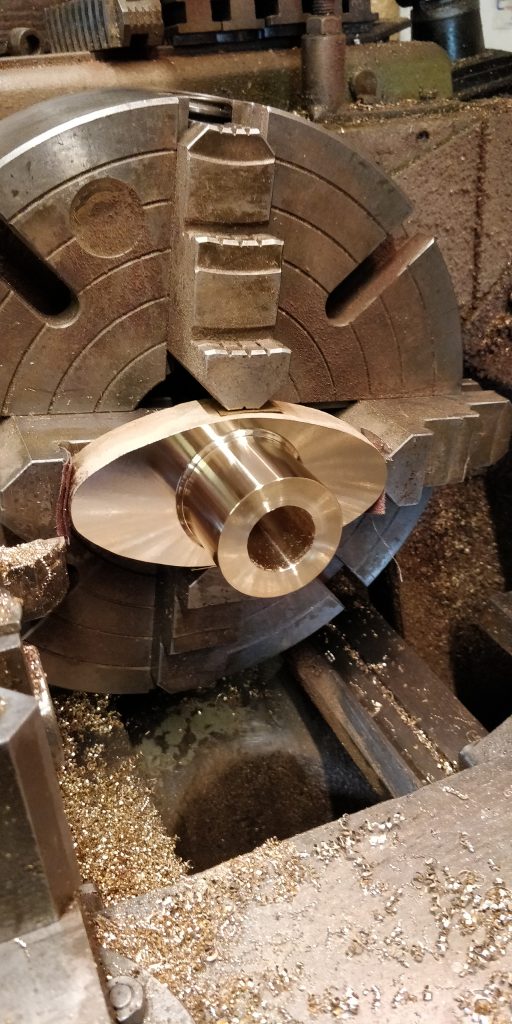 Over at Embsay there has been significant progress with Cumbria. A new regulator gland has been cast and machined following the discovery of a fracture in the old regulator gland. This has now been fitted and packed along with a replacement regulator quadrant.
Over at Embsay there has been significant progress with Cumbria. A new regulator gland has been cast and machined following the discovery of a fracture in the old regulator gland. This has now been fitted and packed along with a replacement regulator quadrant.